Source: DANYLIW RESEARCH SEMINAR ON CONTEMPORARY UKRAINE
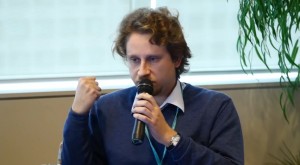
How significant was the participation of the far right in Maidan? Unfortunately, this question quickly falls victim to extreme politicization due to two phenomena: first, active propaganda aimed at discrediting Maidan by its opponents, including the Russian media, and second, by whitewashing attempts by Maidan’s (left-)liberal or moderate nationalist supporters. Despite the hot polemics there are very few attempts to systematically assess the participation of the far right in Maidan. Typically arguments are supported with survey results conducted among participants of the Maidan showing that only a tiny minority of the protesters were members of any political party (3.9% in December 2013, and 7.7% in January 2014), or with data from electoral polls and presidential and parliamentary election results showing little electoral support for Svoboda, the Right Sector party or their leaders.
However, we do possess data that can provide a better estimate for the participation of the far right parties, organizations, and initiatives in Ukrainian protests, including Maidan. For 5 years our team, now working in the Center for Social and Labor Research (http://cslr.org.ua), has tried to systematically employ data collection and analysis of protest events following an established methodology in social movements and contentious politics research. The goal is to create a database of all protest events (as well as either positive or negative reactions to them) taking place on the whole territory of Ukraine, which involves coding a set of variables for each event including all the identified participants mentioned in any reports. Our analysis is based on monitoring the news-feeds of almost 200 web-media outlets covering local news in all Ukrainian provinces (oblasts), as well as some major Ukrainian national media and some activist web-sites representing all major sectors of social-political activity. Over 80% of the sources are local oblast-level news. The data about each protest’s negative or positive reaction includes the date and location of the events, their agents and targets, forms of protest and repression, conflict issues, number of protesters and state forces involved, among other coded information, as well as full-text media reports. At the moment our database consists of around 25,000 events, covering the period from October 2009 till February 2014 and, in addition, August and September of 2014 (after a break). It means now we possess a database covering all events of protest and repression during the whole period of Viktor Yanukovych’s rule.
How does Maidan look in a wider perspective of protest event data, and how significant was the far right’s participation? By “Maidan period” I refer to a period starting from November 21, 2013 (when the first Euromaidan camp began in the evening) and ending on February 23, 2014 – Sunday of the last week of Viktor Yanukovych’s rule. As expected, we see a huge splash of protest events in this period. If during the almost 11 months of 2013 from January 1 till November 20 there were reported 3,428 protest events, during three months of the Maidan period there were 3,949 reported. In other words, it was a relative increase by more than 4 times. But not all of those 3,949 protest events were connected to Maidan. Among them 3,234 were specifically in support of Maidan, while 365 could be attributed to anti-Maidan mobilizations. At least 350 protests during Maidan period were related neither to Maidan nor to anti-Maidan.
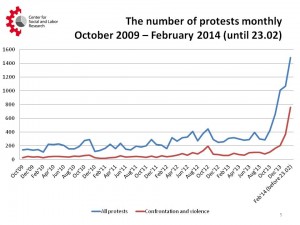 For each event we try to code every protest participant mentioned in the related media reports. In many cases the participants are named only in a generic way: for example, citizens, activists, protesters, students, workers, etc. But in many cases media reports mention specific political parties, non-governmental organizations, informal initiatives or their members who organized or participated in the protest.
For each event we try to code every protest participant mentioned in the related media reports. In many cases the participants are named only in a generic way: for example, citizens, activists, protesters, students, workers, etc. But in many cases media reports mention specific political parties, non-governmental organizations, informal initiatives or their members who organized or participated in the protest.
Among participants of Maidan the far right Svoboda party was most frequently reported by the media. The participation of this party was mentioned in at least 18% of the protest events in support of Maidan. Other parties participated in a smaller number of Maidan protests. In particular, participation of the Batkivshchyna party (Tymoshenko/Yatseniuk) was reported in only 13% of the protests, the UDAR party (Klychko) in 10%, Democratic Alliance (a new Christian Democratic party) in 3%, the Radical party (Lyashko) in 1%. Participation of unspecified “opposition parties” was reported in 2% of the Maidan protests, and those might include Svoboda. In 5% of the Maidan protests participation of only unidentified politicians or local officials was reported. Among the non-partisan participants and initiatives, Automaidan (6%), Right Sector (6%) and Maidan Self-Defense (4%) were the most notable.
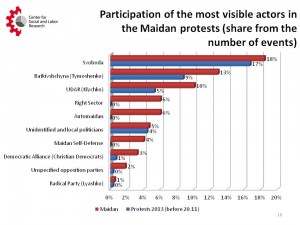 It is important to keep in mind that these are participation levels that were reported by Ukrainian media. Often participants were described in very general terms, for example, “Euromaidan activists.” This is why for 50% of Maidan protest events there was no information about the participation of any particular political party, formal organization, trade-union or ideological initiative, although it might mean that their participation was simply not recognized or not reported by the journalists. It is also important to note that these data are specifically about protest participation. Humanitarian initiatives that were not oriented to protest activity were, therefore, not reported in the messages about protest events. Finally, these data do not differentiate between various scales and types of participation in the protests. We cannot tell from them the number of participants from each organized agent and what precisely their role was in the protests. The most conservative way to look at these figures would be to treat them as an estimation of how visible and recognizable the specific participation was for the mass-media.
It is important to keep in mind that these are participation levels that were reported by Ukrainian media. Often participants were described in very general terms, for example, “Euromaidan activists.” This is why for 50% of Maidan protest events there was no information about the participation of any particular political party, formal organization, trade-union or ideological initiative, although it might mean that their participation was simply not recognized or not reported by the journalists. It is also important to note that these data are specifically about protest participation. Humanitarian initiatives that were not oriented to protest activity were, therefore, not reported in the messages about protest events. Finally, these data do not differentiate between various scales and types of participation in the protests. We cannot tell from them the number of participants from each organized agent and what precisely their role was in the protests. The most conservative way to look at these figures would be to treat them as an estimation of how visible and recognizable the specific participation was for the mass-media.
In general, the far right’s participation (including Svoboda, Right Sector and other ultranationalist parties, organizations or initiatives) was mentioned in 25% of Maidan protests. This percentage was higher for Maidan protests than for the protests in 2013 before the start of Maidan (mostly because of the rise of Right Sector). However, the share of protests with participation of Svoboda did not increase much during Maidan. In fact Svoboda was the most active political party in protest events from 2010, and increased its protest activity from year to year both in absolute numbers and in relative share of total number of protest events (from 12% in 2010 to 17% in 2013).
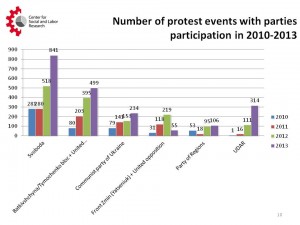 Our data also shows that the protest coalition of the far right with the moderate opposition parties started to form much earlier before the beginning of Maidan. In fact each year from 2010 the number of protest events where both Svoboda and another major opposition party participated (either Batkivshchyna or UDAR or Front Zmin) was growing.
Our data also shows that the protest coalition of the far right with the moderate opposition parties started to form much earlier before the beginning of Maidan. In fact each year from 2010 the number of protest events where both Svoboda and another major opposition party participated (either Batkivshchyna or UDAR or Front Zmin) was growing.
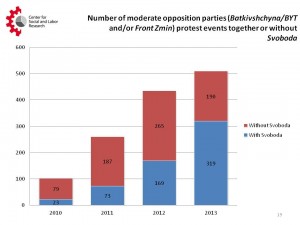 In addition, the visibility of Svoboda and Right Sector were much higher than that of other identified organizations/initiatives during the particularly violent events during Maidan. By violent tactics we refer to protest actions causing (or threatening to cause) direct damage to people or property.
In addition, the visibility of Svoboda and Right Sector were much higher than that of other identified organizations/initiatives during the particularly violent events during Maidan. By violent tactics we refer to protest actions causing (or threatening to cause) direct damage to people or property.
Among the identified participants Right Sector was the most visible initiative in violent Maidan protests; its participation was reported in more than 16% of violent Maidan protest events. Next, there is Svoboda with participation in at least 10% of violent protests. The participation of Maidan Self-Defense initiatives was reported in 7% of violent protests; other parties and initiatives participated in less than 3% of violent events each. The participants of the majority of violent events were described only in a generic way or the actions were attributed to groups of unknowns.
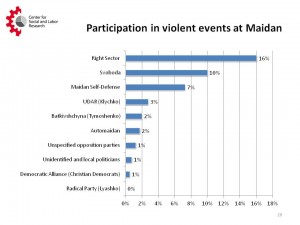 Generally far right parties and groups were mentioned in 26% of violent Maidan protest events, although the far right participation in violent protests before Maidan was not very much lower (20%).
Generally far right parties and groups were mentioned in 26% of violent Maidan protest events, although the far right participation in violent protests before Maidan was not very much lower (20%).
In our data we can also see some important dynamics of participation in Maidan protests. Political parties (including Svoboda) were clearly losing dominance in the protest as it became more and more radical. At the same time, participation of Right Sector and Maidan Self-Defense became highly visible, especially during the last stage of Maidan, starting on February 18 with breaking the truce with Yanukovych followed by the “snipers’ massacre.”
 Finally, the far right’s participation in Maidan had an important regional diversity. Counter-intuitively, after Kyiv (32%), the highest participation of the far right was at local maidans not in the western region, but in the eastern region and Donbas (29%). The lowest participation (except for Crimea) was in the central (24%) and western regions (23%). The same is true for the participation of other opposition parties and/or politicians at local maidans. In the Donbas (54%), southern (51%) and eastern (40%) regions it was higher than in Kyiv (37%), Central (34%) and Western (29%) regions. This regional difference evidently reflects not the local support for the parties and the far right, but rather the local support for maidans. Where the local majority was against Maidan, the more the local maidans were dependent on the organized structures of the opposition parties, including Svoboda. At the same time, the opposition parties and the far right, which already had a very low level of trust from the residents of the southern and eastern regions, might have only pushed those people even further away from Maidan, making a genuine nationwide movement against Yanukovych and approval of Maidan almost impossible.
Finally, the far right’s participation in Maidan had an important regional diversity. Counter-intuitively, after Kyiv (32%), the highest participation of the far right was at local maidans not in the western region, but in the eastern region and Donbas (29%). The lowest participation (except for Crimea) was in the central (24%) and western regions (23%). The same is true for the participation of other opposition parties and/or politicians at local maidans. In the Donbas (54%), southern (51%) and eastern (40%) regions it was higher than in Kyiv (37%), Central (34%) and Western (29%) regions. This regional difference evidently reflects not the local support for the parties and the far right, but rather the local support for maidans. Where the local majority was against Maidan, the more the local maidans were dependent on the organized structures of the opposition parties, including Svoboda. At the same time, the opposition parties and the far right, which already had a very low level of trust from the residents of the southern and eastern regions, might have only pushed those people even further away from Maidan, making a genuine nationwide movement against Yanukovych and approval of Maidan almost impossible.
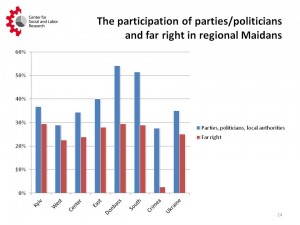 This preliminary analysis indicates that the far right’s participation in Maidan was anything but insignificant. The far right groups were the most visible identified collective actors among Maidan participants, with the largest share of reported participation in Maidan protest events and specifically in violent events, which had a crucial significance and usually attracted the most attention. The far right groups were the most frequently mentioned collective actors at all stages of Maidan. Despite the decline in Svoboda’s participation in the last days of the armed insurrection, Right Sector took first position. Against all expectations, the far right groups (as well as political parties or politicians in general) were more frequently mentioned at the local maidans in the eastern and in the southern regions than in the western or central, i.e. precisely where they had the lowest support among the local residents.
This preliminary analysis indicates that the far right’s participation in Maidan was anything but insignificant. The far right groups were the most visible identified collective actors among Maidan participants, with the largest share of reported participation in Maidan protest events and specifically in violent events, which had a crucial significance and usually attracted the most attention. The far right groups were the most frequently mentioned collective actors at all stages of Maidan. Despite the decline in Svoboda’s participation in the last days of the armed insurrection, Right Sector took first position. Against all expectations, the far right groups (as well as political parties or politicians in general) were more frequently mentioned at the local maidans in the eastern and in the southern regions than in the western or central, i.e. precisely where they had the lowest support among the local residents.
Why did this happen at all? Our data indicates that significant far right involvement in Maidan protests were hardly an invention of hostile Russian media. On the contrary we can see a natural and inevitable continuation of the previously formed protest coalition between the moderate opposition parties and Svoboda. This protest coalition was formed during Yanukovych’s rule when moderate opposition parties were cooperating more and more with Svoboda. These parties were possibly interested in the higher mobilization potential of Svoboda, which had more ideological activists and a wider network of genuinely committed local activist cells. At the same time the moderate opposition, even before Maidan, legitimized the far right as a part of “normal” Ukrainian politics without any serious challenge to their reactionary and anti-democratic ideology. With this history and with their mobilization resources Svoboda’s later entrance on Maidan, and its shaping Maidan’s image and rhetoric, was more than natural. Despite some criticism, it went without serious challenge. This general tolerance of the far right against the “greater evil” of Yanukovych allowed Svoboda to play the most visible role in Maidan protests and later helped to de-legitimize them for the majority of the population in southeastern Ukrainian provinces, thus forming the ground for the civil war.
But examining the low electoral results of both Svoboda and Right Sector shows the need for more specific research in order to understand why these groups lost their opportunity to become the true vanguards of the Maidan uprising and convert their high visibility into strong power positions. In any case we should not forget about other dimensions of the far right influence on Ukrainian politics beyond electoral results: mainstreaming slogans previously used only in the nationalist subculture, popularizing radical figures of the past and their ideologies, making an impact on the rhetoric of other major political actors, their paramilitary and military affiliated structures and their potential to take arms against the state.
—
Volodymyr Ishchenko is a sociologist studying social protests in Ukraine. He is the Deputy Director of the Center for Society Research (Kiev), an editor of Commons: Journal for Social Criticism, and a lecturer at the Department of Sociology in the Naitonal University of Kyiv-Mohyla Academy.


18 replies on “Maidan, the Right-Wing and Violence in Protest Events Analysis”
So Where is the imperialist Russian extreme right?
I was not aware that the Ukrainian extreme right posed a threat to Ukrainian national independence.
We can only hope that if Mr. Ischenko’s is as concerned about democracy as he claims, his next article will cover the imperialist Russian extreme right– both in Russia and Ukraine. Mr Ischenko might also explain to all of us why there even exists a Russian right in countries outside Russia.
The argument about the far right in Russia is a classic example of a ‘what about?’ argument when you are pressed against the wall start to point to the problems in other countries as if they somehow justify ignorance about the problems in Ukraine. In case we do not collect such protest data in Russia. It would require a hell more resources.
As for the Russian far right within Ukraine. We do possess such data and later it might be possible to make an analysis about them. However, before anti-Maidan they were completely marginal in the protest activity, not even comparable to Ukrainian far right.
“However, before anti-Maidan they were completely marginal in the protest activity…”!!
And Mr Ischenko gives us a classic case of ignoring the elephant in the room.
Of course the modern day extremist Russian Black hundreds were “marginal in the protest activity.” The “activity” was directed against a government supported by their sponsor — the Kremlin. There was no reason for Ukraine’s Russian imperialist right to engage in anti government “activities” until the Yanukovitch government was deposed as that pro Kremlin regime was turning Ukraine back into a Kremlin sattellite dominated by Ukraine’s culturally and politically russophile minority.
Hopefully the “data” Mr Ischenko has goes back at least to 2005 when the Kremlin renewed its support for pro-Russian latter day Black Hundred gangs in Crimea and eastern Ukraine. Might we even hope he goes back a century or two to explain the legacy of 200 years of Russian settler colonialism and imperialism to the uniformed? Ukrainian and Russian marxists in the1920s seem to have had no problems in discussing this subject — unlike all too many marxists today.
IN any case , in 2005, the Kremlin created the organization “Donetsk Republic” from the modern-day descendants of the early-20th century Black Hundreds. Its leaders went to Russia in 2006 to participate in the summer camp of the Eurasian Youth Union that was established in 2005 with the money from the Presidential Administration of Russia on the initiative of Aleksandr Dugin, and Vladislav Surkov.
This summer camp trained activists in “activity” against democratic non- russian national – liberation movements in ex-soviet states. Like Nashi and Rodina were formed to violently counter in Russia itself Russian liberals and radicals. Among the participantof the summer camp, As Anton Shekhovtsov tells us, was Andrey Purgin, who is now “First Prime Minister” of the “Donetsk People’s Republic”.
Elephant in the room? Do you have any data to prove any significance of ‘Black Hundred gangs’ and ‘Donetsk Republic’? Protest activity? Membership? Number of ‘gangs’ victims? Anything?
Our data goes back to October 2009. The Russian far right was totally marginal even in the last months of Yushchenko rule.
From what i have read of ischenko it seems to me he is lost somewhere between the poles of bourgeois empiricism and Stalinist anti-Ukrainianism. Perhaps before trying to determine what he should count and when he should begin, he should do some serious thinking about categories and context so he can explain why what he is counting is significant.
Let us imagine, for instance, Ireland 1920. The IRA is beating-up and killing those it deems pro English and anti Irish. Is this anti-democratic fascist violence or the anti-colonialist violence of the colonized for national liberation? Is IRA killing equivalent to killing by the Black and Tans? The Ulster Special Constabulary? Do marxists condemn all of them – as do liberals?
Let us imagine Algeria 1962. The OAS is killing those it deems supporters of Algerian independence. Is this a “self defence” anti terrorist group of an oppressed minority, or a settler-colonist based agent of imperialism maintaining domination– even though De Gaulle in the imperial center conceded Algerian independence? And finally, let us imagine Palestine 1947. Haganah and Irgun are killing those opposed to the creation of Israel. Anti-colonialist violence of historically oppressed Jews or Zionist imperialism? the Communist Party of Israel (MAKI); and the United Workers’ Party of Israel (MAPAM) at the time came down on the Israel side it should be noted.
I have chosen Ireland Algeria and Israel because there we had non-marxist movements that most closely resembled SVOBODA – which, unlike right extremist fascists supported by Putin today in the rest of EUROPE is anti-Russian and not pro-Russian.
In light of such questions we can then ask: is ischenko doing his counting to condemn violence in general or just the anti-colonialist violence of the colonized? If the answer is yes, then, both cases this seems more like bourgeois liberalism that supports the political status quo (Russian domination of Ukraine) than revolutionary Marxism.
From what i have read of ischenko it seems to me he is lost somewhere between the poles of bourgeois empiricism and Stalinist anti-Ukrainianism. Perhaps before trying to determine what he should count and when he should begin, he should do some serious thinking about categories and context so he can explain why what he is counting is significant.
Let us imagine, for instance, Ireland 1920. The IRA is beating-up and killing those it deems pro English and anti Irish. Is this anti-democratic fascist violence or the anti-colonialist violence of the colonized for national liberation? Is IRA killing equivalent to killing by the Black and Tans? The Ulster Special Constabulary? Do marxists condemn all of them – as do liberals?
Let us imagine Algeria 1962. The OAS is killing those it deems supporters of Algerian independence. Is this a “self defence” anti terrorist group of an oppressed minority or a settler-colonist based agent of imperialism maintaining domination– even though De Gaulle in the imperial center conceded Algerian independence? And finally, let us imagine Palestine 1947. Haganah and Irgun are killing those opposed to the creation of Israel. Anti-colonialist violence of historically oppressed Jews or Zionist imperialism? the Communist Party of Israel (MAKI); and the United Workers’ Party of Israel (MAPAM) at the time came down on the Israel side it should be noted.
I have chosen Ireland Algeria and Israel because there we had non-marxist movements that most closely resembled SVOBODA – which, unlike right extremist fascists supported by Putin today in the rest of EUROPE is anti-Russian and not pro-Russian.
In light of such questions we can then ask: is ischenko doing his counting to condemn violence in general or just the anti-colonialist violence of the colonized? If the answer is yes, then, both cases this seems more like bourgeois liberalism that supports the political status quo (Russian domination of Ukraine) than revolutionary Marxism.
So, no data, no evidence on the ‘Black Hundred gangs’? 🙂
Your historical parallels are very loose. How can you justify them? How can we compare contemporary Ukraine, an independent state with its own grande bourgeoisie, to the Ireland and Algeria under direct colonial rule?
So, no answer to the question: opposition to all violence or just the anti-colonialist violence of the colonized? No phenomenon can be understood unless it is viewed in comparison with something similar.
ALgeria was not under direct rule from Paris. It was controlled by the local French settlers and descendents. Much like Ukraine post 91 controlled by local descendents of colonizers and political-cultural loyalist russophiles —sovoki-kreoli.
Ireland was ruled directly from London after 1801 but retained its social economic and national paticularities that allows it to be classified as “mixed settler type colony.” Again similar to pre91 Ukraine.
Direct rule ended 1991. Now we have a neo feudal country with a compradour kreol bourgeosie opposed by a national bourgeoisie. For any serious marxist it follows nationalism here still plays progressive role because it is anti imperialist. In vulgar terms, the main enemy now is not nationalism but imperialism.
Consequently issue of violence in ukraine since 91 plays out in totally different context than in long established nation states. All of which bourgeois empirical analysis like yours ignores.
‘From 1848 until independence, the whole Mediterranean region of Algeria was administered as an integral part of France, much like Corsica and Réunion are to this day. ‘
It’s totally non-sensical and ahistorical to compare contemporary Ukraine-Russia relations with Algeria or Ireland. It can be justified only by your extreme nationalist ideological prejudices (attempts to justify xenophopic antisemitic Svoboda are very much revealing).
‘Neo-feudal’ country with comprador bourgeoisie opposed by a national bourgeoisie? Please, don’t teach me your ‘revolutionary Marxism’ any more :))) It’s not Marxism, it’s just a crazy mix of ultranationalism, post-Soviet vulgar sociology and freaky Ryabchuk’s writings about ‘kreols’ in Ukraine.
As you are obviously either a fool or a knave whose knowledge of history and Marx seems limited to the KRATKII KURS ISTORII KPZU I see no reason to continue this exchange:
Answer not a fool according to his folly, lest thou also be like unto him
Very interesting Volodymyr, thanks!
Does this mean ultranationalists such as the Right sector played a bigger role in Eastern Ukraine? Or perhaps they were just mentioned more often in the media?
What do you think of the ultranationalist influence on the mainstream public? My understanding is, they basically popularized slogans such as ‘glory to Ukraine, glory to the heroes’. Previously, it was almost unknown a politician like Poroshenko would use it in an election campaign
For Southern and Eastern Ukraine this is a question whether the far right indeed played a bigger role or whether the local media were more sensitive to far right participation. I’ll try to go deeper into the dataset later. In any case they were more visible and this fact on its own had grave consequences.
As for the far right influence I just wrote a short comment for the Guardian: http://www.theguardian.com/profile/volodymyr-ishchenko
Peter is right. Ischenko is wrong.
James Connolly fought with and not against Michal Collins. Even the
Stalinist PCF and Algerian CP supported the FLN.
Ukraine is still neo fuedal because relations remain primarily patrimonial not
contractual. Most the population cannot live solely from market
relations. They rely on barter, mutual-aid and kinship.
At best, Ukraine has been frozen in a condition of primitive capitalist primary
accumulation since 1929. First, of the state-ownership type, now of
the private bandit type.
Oligarch-bandits engage in speculation theft and usury. They do not produce
the means of production or infrastructure.
Ischenko apparently lives in a world where there is no such thing as
Russian imperialism or colonialism. Readers must ask Is he merely a
“useful idiot” or, more sinister, a Little-Russian version of Karglitsky.
The worst thing about ‘friends of Ukraine’ like you is that you reproduce Western orientalist myths about Ukraine that share so little in common with Ukrainian reality. The whole point about ‘neo-feudal Ukraine’ is one of the best examples. I am not even saying about the lack of a slightest relation to Marxist concept of feudalism.
I criticized Russian propaganda and Russian imperialism in almost each of my texts during and after Maidan but you prefer to see only what you like to see. The real problem is not that I allegedly criticize Russia not enough but that YOU and the people like Velychenko want to justify Ukrainian far right anti-democratic, xenophobic, sometimes openly racist forces.
Having data is always good. But I wonder how much we can tell about the nature of Euromaidan protesters on the basis of data derived from press reports about those protesters. Of course the choice of source is understandable: media descriptions can provide a numerical, measurable resource, and it’s not like there were academic volunteers on the square counting and classifying protesters from day to day. But might the result not obscure more than it reveals?
For example, how many protesters identified with any political group or party at all? How many were just fed-up with the government, without feeling any particular affinity to one or the other specific opposition party? It’s probably impossible to answer that question. But is it plausible to suggest it was a majority? That seems to be true with mass protests elsewhere in the region, at least (Bulgaria, Hungary). If it was, how would that be reflected in press reports? Not at all? Or in ways (eg the blanket references to unspecified “opposition groups” you mentioned) that don’t yield the kind of tallies you rely on in the end?
The risk here is that you end up with a suggestion that Euromaidan was dominated by Svoboda c.s. that’s based on an unbiased finding of your quantitative research (Svoboda mentions were far more numerous than those of more mainstream parties), that is nevertheless fundamentally incorrect (because that tally wouldn’t reflect how many protesters weren’t affiliated with any of them).
A related question is to what extent press reports are reliable witnesses of protests in the first place. From well-intentioned journalists who intuitively focus on that which stands out rather than the drably common in a demonstration, to sensationalist reporting focusing on the gaudy extremes in order to sell papers, news reports can provide an evocative picture of the most remarkable things about a protest while failing to present a remotely representative image of most protesters. It’s the bane of every protest organizers.
For example, going back a bit in history, what would a research exercise like this have concluded about who took part in the Seattle WTO protests? How many mentions of the Black Bloc rioters would it find in the press reports? Versus how many mentions of the much more numerous participants from labour and environmental groups? Would it have to conclude, based on the data set it was using, that “The Black Bloc was the most visible identified collective actor among WTO protest participants, with the largest share of reported participation in WTO protest events and specifically in violent events”? And would that have helped the reader to better understand what the WTO protests were all about?
Black Bloc participation in anti-globalist and anti-capitalist mass protests was not new to the Seattle protests either, so would the research exercise then conclude that “we can see a natural and inevitable continuation of the previously formed protest coalition between the labour/environmental groups and the Black Bloc”? And would that have helped the reader to better understand what the WTO protests were all about?
The data presented here are great. Obviously participation of the far-right was “significant” (which is a pretty ambiguous/malleable word anyway). But beyond that, drawing and presenting conclusions from these data would have to be done very careful, maybe more careful than was done here. Because the big unknown would remain to what extent the findings say something about the nature of the protest participants, and to what extent more about the nature of press coverage.
Thank you for the extended comment!
First, I need to note that this is not more than an extended summary of the longer paper I presented for Danyliw Research Seminar on Contemporary Ukraine: http://www.danyliwseminar.com/. In the paper I devote much more space to methodological discussion, particularly, to the media sensationalism. Quoting from the paper:
‘However, the rate of media reporting is not a product only of journalists contingent will to report this or that protesting agent and not just a product of the way mass-media function but it does (at least to some extent) reflect some objective variation in protest participation. A deeper analysis is necessary; however, even now we can rule out the most obvious counter-explanations. For example, the higher level of Svoboda visibility is not explained out by its general recognizability as a party represented in the parliament with all corresponding benefits for publicity compared to less resourceful non-parliamentary parties or civic initiatives. The major opposition parties – Batkivshchyna/Yulia Tymoshenko Bloc and UDAR – led by the most recognizable celebrities in Ukraine were less reported in protest events both before and during Maidan. Moreover, Svoboda was the most frequently reported political party in the protest events in 2010-2012 even before it got into the parliament.
Another obvious explanation might be that radicals are typically more visible in the media coverage of protests because they more frequently than moderate agents participate in more provocative and violent actions that attract media looking for sensations. We can roughly check this hypothesis. It might be true for the Right Sector as 34% of the protests with its participation were violent and 24% were confrontational (compared to 12% and 24% respectively for Maidan protests in average). But this is not true for Svoboda: only 7% of their protests were violent and only 11% were confrontational (relatively less than in average). The overwhelming majority of the protest events with Svoboda participation (83%) were conventional and hardly attractive to the media.
My explanation for the highest reporting participation is that Svoboda is indeed structurally different from a typical Ukrainian party, it has objectively higher potential to participate in a number of local protests all around Ukraine, and it indeed realized this potential during Maidan as well as before its start. Unlike the typical political parties in Ukraine (including the former moderate opposition) which function more like electoral machines with low level of grassroots participation even frequently employing people for small fees to participate in the mass events under the party banners, Svoboda is a mobilization party with a wide nation-wide network of local cells of ideologically committed activists. ‘
Responding the substantive argument. Of course, visibility in protest events and the share of the far right membership among the total number of the protesters are two different dimensions. I may agree that a survey among the protest participants might have given a better understanding, for example, of the causes for mobilization. But I totally disagree that this would be a good way to analyze the consequences of the mobilization. The active organized minorities might play even more crucial role (especially at critical points) than the crowd of atomized people. In fact the argument about small far right membership seems to be just trivial. Probably in every mass mobilization, the political groups are heavily outnumbered by ‘ordinary citizens’, precisely, because it is a MASS mobilization. But in the end it is the political leadership that makes a disproportionate influence on the strategy and gains disproportionate benefits from the mobilization’s success (even if not coming to power).
And in your exampe with the Black Bloc. I am sure that protest events analysis would show a high visibility for the Black Bloc. And like with the Right Sector it indeed had detrimental consequences for the movement exploited by hostile media. Though I am not really sure that Seattle coalition was really so natural as in case of Maidan. It was in fact unexpected that the coalition was so diverse and that the moderate trade unions and radical environmentalists and anarchists joined the same campaign (‘teamsters and turtles together again’). Moreover, unlike with the far right in Maidan there was indeed a big and hot debate within alternative globalization movement about Black Bloc participation. During Maidan Svoboda’s and Right Sector’s participation was problematic only for small circles of liberal and even smaller circles of leftist intellectuals. Opposition leaders stopped even mentioning this after mid-January violent escalation.
Like ischenko you ignore context.
OCCUPY occured in established nation states —as well as in imperial centres. It had no national content. Consequently it fizzled. Nothing changed. Same neo liberalism still rules.
Nationalism plays a different role here than in colonized dependent countries.
Maidan occured in a colonized or neo colonized country which Ukraine most surely is despite the refusal of ccertain comrades to accept this fact. Maidan is basically a third attempt at a bourgeois revolution. Like OCCUPY it started as a social movement. Like OCCUPY would have fizzeled if not for the natinal liberation issue. Like Dzuiba and UCP used to say. Ukrainian question is simultaneously a national issue as well as social issue.
Perhaps this time the succesful bourgeois revoution Ukraine should have had 100 years ago will succeed.
And in case anyone still thinks lenin is relevant he said ” the bourgeois nationalism of any oppressed nation has a general democratic contenct that is directed against oppression.”
It might be useful to look at the links section of this site which has many articles on Ukrainian history and especially it’s buried left tradition. http://ukrainesolidaritycampaign.org/links/